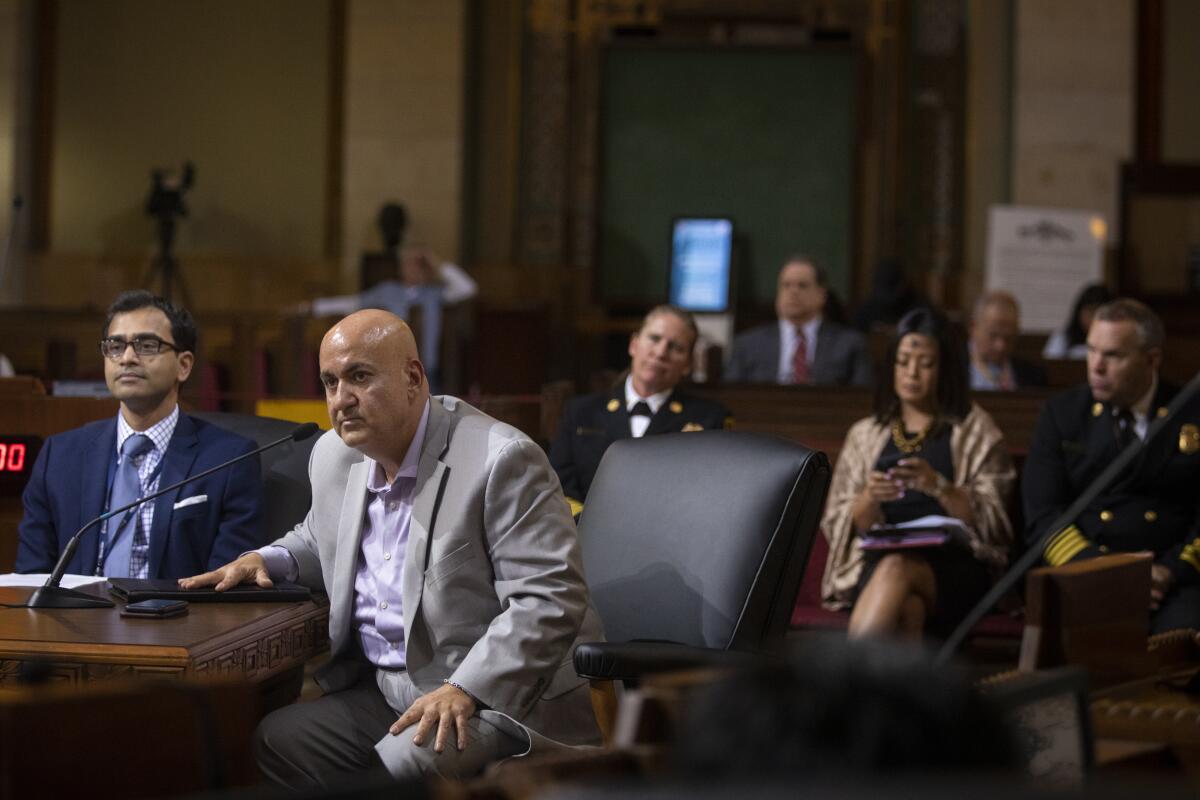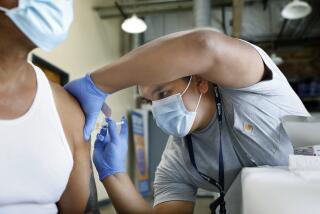L.A. health agencies already strained by coronavirus. And it’s expected to get worse

As the frontline workers against the spread of disease, local public health departments are straining to respond to an outbreak of novel coronavirus and could be overwhelmed in the coming weeks as cases mount within the United States.
City and county health departments carry out the task that is proven to slow outbreaks: Separating sick people from healthy people. The function is simple in theory but often resource-intensive.
Only 70 cases of COVID-19 have been diagnosed in the U.S. so far, yet government healthcare workers nationwide are already monitoring thousands of people who returned from affected countries or had close contact with people who were sick, while also holding regular discussions with hospitals, schools and businesses to prepare for the possibility of a pandemic.
The coronavirus outbreak has tested the capacity of these local agencies and could merit an unprecedented response if the virus begins spreading within the U.S., as some fear. In the last week, officials have announced that eight people, all on the West Coast, contracted the virus within their communities, suggesting people are catching the virus locally
For weeks, public health workers in California have been billing overtime as managers bring in temporary staff to help out. San Francisco and Orange counties declared states of emergency this week because of the coronavirus outbreak.
In Los Angeles County, officials are discussing the possibility of a similar declaration. They also plan to request $7.5 million from the federal government to cover the costs of dealing with coronavirus.
“The problem with novel coronavirus is that we just don’t know as much about it, so the science isn’t there to support every strategy in our toolkit,” said Barbara Ferrer, director of L.A. County’s Public Health Department. “A lot of people are working seven days a week.”
The coronavirus outbreak that began in China late last year has infected 86,000 people and killed 2,900. Now that the virus has spread to almost all continents, experts are increasingly predicting that it will be impossible to contain.
For months, health workers have sought to prevent the disease from taking root in the U.S. Without a vaccine or medical treatment for the disease, standard public health measures of testing, screening and isolating sick patients are vital, experts say.
Those protocols may be determined by federal officials but are carried out by 3,000 public health departments across the nation, including more than 50 in California.
The bulk of the work in California so far has been following up with travelers who have returned from China and have been asked to self-quarantine and limit interactions with others for 14 days. Scientists believe that it can take up to two weeks for people to develop symptoms of the virus.
Since Feb. 2, more than 8,400 such travelers have entered California, according to the state Public Health Department. In San Bernardino County, staff members are monitoring 75 of them with the help of temporary staff, according to department officials.
“Should the lists grow in size, we may not be able to respond effectively,” the officials said in an email to The Times. “Should follow-up on individuals continue to be a long-term activity, we would need more staff.”
Federal officials provide local health departments with long lists of people who flew through or out of China and landed in the United States. Health workers in those communities then have to figure out how to contact the returning travelers and make sure they have a place to safely isolate themselves for two weeks, Ferrer said.
In L.A. County, where there are 1,000 such cases, each patient is assigned a nurse who fields any calls from them. The nurse calls and texts the patient every other day to check in on them and make sure they aren’t going to school or work, as well as taking their temperature every day.
Ferrer said she had to move nurses who work in other divisions to help with the workload. Every day, 100 to 200 people in L.A. County return from a trip that included travel to mainland China in the last 14 days and need to be monitored, she said.
“It’s a lot of calls, and it’s a lot of making sure people are OK. We make sure they have thermometers, we make sure they have food, we answer their questions,” she said. “It’s a role that I don’t know that a lot of people appreciate.”
The panic that often has surrounded this outbreak also falls to public health departments to quell. In Long Beach, the 24-hour call line for health questions from schools and hospitals has been ringing more than ever with questions about coronavirus and who should be tested, said Emily Holman, the city’s communicable disease controller.
“There’s still quite a bit of fear,” she said.
Health departments’ workloads will grow tremendously if coronavirus begins spreading in large swaths of the United States. For each confirmed case, staffers trace the path of the infected patient for the days they could have been making other people sick. Then they contact anyone they may have had contact with to tell them to watch for symptoms and sometimes quarantine themselves. Health workers in Santa Clara and Sacramento counties are scrambling to contact and quarantine hundreds of people who came into contact with COVID-19 patients there.
The single confirmed coronavirus case in L.A. County had contact with more than 50 people whom the Public Health Department then had to monitor, Ferrer said.
The first confirmed case of COVID-19 in the United States, in Washington state, led health workers there to 70 people who may have been infected, said Dr. Jonathan Wiesman, that state’s secretary of health.
“We’ve been working constantly, so it’s just keeping people refreshed and cycling in and giving them rest breaks,” Wiesman said.
On Saturday, Washington health workers’ to-do lists grew even longer, as officials announced the first death from COVID-19 in the U.S. on Saturday as well as an outbreak at a long-term care facility in a Seattle suburb.
In Los Angeles, the City Council convened a special meeting on Wednesday to discuss the response to the coronavirus outbreak. Council members asked whether there were plans to care for homeless people should they become infected, as well as how to keep people informed without stoking panic or xenophobia.
Officials from multiple city departments are meeting regularly to make sure preparations are in order for a possible worst-case scenario, said Aram Sahakian, general manager of the Los Angeles Emergency Management Department.
“There’s planning to do right now,” Sahakian told the City Council. “We’re not waiting until it comes to us.”
California counties are now revising plans they are required to have in place for a pandemic. Some health departments said they were trying to increase their supplies of masks but face a worldwide shortage.
In L.A. County, a pandemic influenza plan is being updated for coronavirus, said L.A. County epidemiologist Dr. Prabhu Gounder.
“They are thinking about those things, like the different scenarios we could imagine: What would happen in schools? What would happen in homeless shelters? What would happen in skilled nursing facilities?” Gounder said. “What would we do about shortages of supplies? What do we do if there aren’t enough ventilators?”
Ferrer has been holding regular briefings with schools, businesses and event spaces to discuss protocols in the event of more coronavirus cases. Officials with the federal Centers for Disease Control and Prevention earlier this week advised schools to prepare for internet-based learning and businesses to think about how to use teleconferencing in the event that COVID-19 spreads and people need to work from home.
The department set up a dedicated line to field calls from businesses and other organizations with questions about outbreak preparations, she said.
“It might never happen. We might never have a big outbreak here, but this is the time for everyone to make sure they know what they want to do if there is one here,” she said. “Nothing wrong with being well-prepared.”
More to Read
Sign up for Essential California
The most important California stories and recommendations in your inbox every morning.
You may occasionally receive promotional content from the Los Angeles Times.











